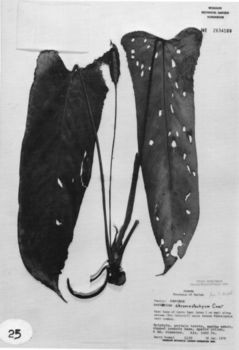



Anthurium chromostachyum Croat, sp. nov.
TYPE: Panama. Darien: E base of Cerro Sapo, 1,000 m, Hammel 1130 (MO 2634169, holotype; PMA, isotype).
Epiphyte; stems ca. 1 cm diam., internodes short; cataphylls subcoriaceous, 10-13 cm, acuminate at apex, turning reddish brown, persisting intact.
LEAVES with petioles erect and blades pendent; petioles terete; 25-34 cm long, ca. 4 mm diam.; blades oblong-triangular, subcoriaceous, narrowly long-acuminate at apex, sub-cordate at base, to 31 cm long, 10-13 cm wide, broadest at the base; the anterior lobe 29-33 cm long, more or less straight along most of the margin, the posterior lobes 4.5-6 cm long, directed somewhat outward; the sinus arcuate to parabolic; the surfaces drying matte with many, minute raphide cells visible on the upper surface, the lower surface only slightly paler than the upper surface; basal veins 4-5 pairs, the first 3 pairs free to the base, the fourth to fifth free or weakly coalesced; primary lateral veins 4-6 per side, departing the midrib at 25-40° angle, moderately straight to arcuate to the collective vein, drying prominulous below; interprimary veins frequent; the tertiary veins moderately obscure; collective vein arising from the first basal vein, inconspicuous, loop-connecting the primary lateral veins.
INFLORESCENCE usually shorter than the leaves; peduncle 18-26 cm long, 3-4 mm diam., terete, two-thirds as long as or slightly longer than the petioles; spathe subcoriaceous, oblong-elliptic, 5.5-7.5 cm long, 1.7-2.3 cm wide, abruptly acuminate at the apex, somewhat clasping at the base, inserted at ca. 45° angle on the peduncle; spadix sessile, yellowish to rose-colored, scarcely tapered toward the apex, 4-6 cm long, 5-6 mm diam., the flowers 4-lobed, 1.2-1.5 mm wide in both directions, 8-12 flowers visible in the principal spiral; tepals drying matte, the lateral tepals 0.6-0.9 mm wide, the inner margin straight to broadly rounded; the anthers ca. 0.35 mm long, 0.25 mm wide (dried), held m a tight cluster around the pistil.
INFRUCTESCENCE not seen. Fig. 25.
Anthurium chromostachyum is endemic to Panama in the Serranfa del Sapo in southeastern Darien Province at 330 to 830 m in what is probably a premontane wet or premontane rain forest life zone.
The species, a member of section Calomystrium, is distinguished by its slender stem, its persistent, intact cataphylls, its terete petioles, its subcoriaceous, oblong-triangular blade with a subcordate base, and by its inflorescence that is shorter than the leaves with a yellowish to rose-colored spadix.
The species is probably most closely related to Anthurium cucullispathum, another member of section Calomystrium that has a similar blade shape. The latter species, with only one dubious collection from eastern Panama, is known principally from Veraguas and Code Provinces. It differs in having blades that dry with more prominent veins and with a dense pattern of dark, elevated gland-like structures on the lower surface (visible without a lens). It also differs in having a white spadix at anthesis.
António 3801 from near Portobelo in Colón Province may also be this species. This collection differs in having more or less oblong blades, five to six times longer than broad that are narrowest midway and broader toward both the apex and the base. More material must be seen to determine its exact status.

Map of Mesoamerican specimens with coordinates
Panama Darien: 550-830 m, 7.58N 78.23W, 25 May 1991, Gordon McPherson
15381 (MO).
Darien: Cerro Sapo, llammel 1130 (MO, PMA), 7200 (MO).